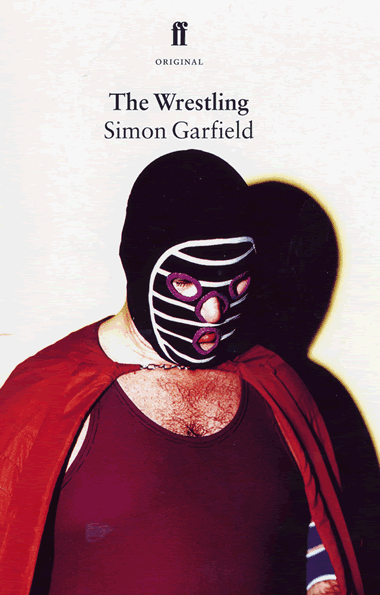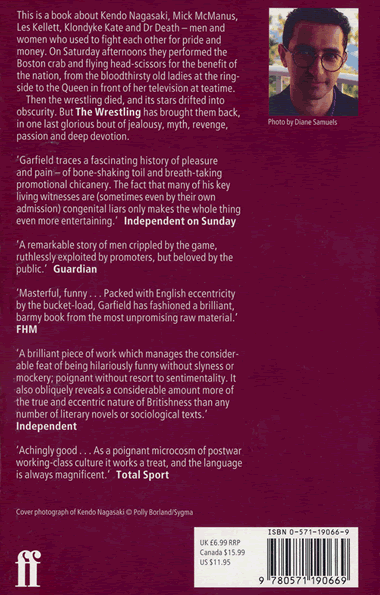The Wrestling
The Wrestling


About the Book
This book has more mentions of the Boston Crab than anything else I’ve ever written.
The Wrestling began as an article for the Independent on Sunday. I was trying to explain how, in the mid-1990s, the American lunkheads of the World Wrestling Federation had taken such a hold on the imaginations of young children. Men who called themselves The Undertaker and Hunter Hearst Helmsley had long since abandoned the pretence of real fighting, and were involved in soap-opera storylines involving the WWF owner and his daughter. I had been to see these men perform in the United States, and it made me yearn for the days of two falls, two submissions or a knockout. When I returned to London I sought the views of the old British grappler Mick McManus (catchphrase: ‘Not the ears!’) We met for a spot of lunch at the Wig and Pen, his club in Fleet Street. As I explained in the book’s epilogue, Mick was a regular there, and people were grateful to see him. He wore dark blazer and slacks. He was a little flabby, but retained the spring of a muzzled fighting dog. His speech was gruff and unrelenting, and he kept it low so as not to worry the other gents in the room. McManus said he tried to pop in whenever he was in town (he lived in a flat in Denmark Hill). He ordered the steak and kidney. The waiter asked whether he wanted vegetables, but McManus said, ‘Nah!’ I had a mushroom omelette, which I thought to be rather pricey at £8. ‘That’s good value that!’ McManus reasoned.
When I visited Mick at home he showed me some photos of him with various celebrities – Tommy Cooper, Rod Hull & Emu, the Rolling Stones, Magnus Pyke, Raquel Welch – and it was apparent that those stars were genuinely thrilled to meet Mick. It became clear to me that the book should be about the process that transformed the wrestlers from popular personalities to people who were suddenly almost unemployable. Greg Dyke was to blame, for when he was head of ITV Sport he decided that the wrestling was a little too downmarket for his advertiser’s tastes, and so he pulled it from the schedules.
I had a terrific time writing it. I attended a wrestlers’ reunion, and visited many wrestlers, old and new, in their homes. The good news was, many of them still hated each other. Being both great athletes and actors, they had many fine stories to tell. For a while I had visions for an exciting ending for the book, one which would involve me climbing into the ring and going a few bruising rounds with a pro. I worked out a bit at the local gym, where I had some difficulty with the forward roll. I practised saying ‘Not the ears!’ and ‘Ask him, Ref!’, but no one seemed overly impressed. I asked Jackie Pallo what I would need to become a good fighter, and he said, ‘a complete change of DNA’. So I chickened out, fearing that I would have ended up in hospital, if not dead. The book closes instead with a nice quote from the painter Peter Blake, who concluded that we have lost something singularly British, but perhaps we shouldn’t regret its passing. ‘It had its day, and it was wonderful.’
I think the book holds up well. At the beginning of 2005 I met a reader who said that The Wrestling was the book he always turned to when he was feeling down, and I was very touched. There are vague plans for a tenth anniversary reissue, although it will need a new epilogue. Sadly, many of the stars of the book have been counted out for the last time: Les Kellett, Big Daddy, Giant Haystacks, Kent Walton, Brian Glover and Pat Roach are no longer with us, and I am grateful I met them when I did. Apart from Les Kellett – but for that saga you’ll have to read the book.
A year after publication it was turned into an hilarious one-man play by Alex Lowe, who transformed himself into a great many characters, including Jimmy Savile (‘My proud boast is that I lost my first 35 fights’), Brian Glover (‘I’m a very posh actor – I can’t be doing with Masambula’) and Max Crabtree, brother of Shirley Crabtree (‘He would have shown his private parts on television if he thought it would have done him some good.’)
It played to appreciative houses in Edinburgh and London, and was described on the Late Review by Pat Bomber Roach as ‘good’.
The extract here is taken from Chapter 12, and concerns the curious and huge life of Giant Haystacks. In the Journalism section you will also find an interview of sorts with the mysterious Kendo Nagasaki.
The Wrestling
Extract
From Chapter 12: ‘I travel alone,’ said Giant Haystacks
Max Crabtree: The big fella? Oh God, He’s a bad’n. He’s a profound liar, let’s start with that. A big horrible man. I started him, but he won’t tell you that. I was running the King’s Hall, Belle Vue, and an old-time wrestler called Billy Graham brought him down. He was working on a club door. In those days he weighed about twenty-six stone. Looked quite tidy. Then he blew himself up, and at one time he was about forty-eight stone. A great guy, but born a liar.
Brian Dixon: Haystacks started with me very early on, before all the other big names came over. We needed a giant. I gave him the name Haystack Colhoun. I’d seen the name in an American magazine. Then we came up with Haystacks. It seemed fitting at the time. People got sick of him, but they’d still come and see him. He’s such a huge man – people are mesmerised by him.
Simon Garfield: The first time I saw Haystacks in the ring was in 1992 at Tunbridge Wells. He was in against Franz Schumann, a dashing Austrian thirty stones lighter.
‘ Wrestling,’ Haystacks announced before the contest, ‘is the only way to release my pent-up feelings without being prosecuted.’
I found Franz Schumann shaking gently backstage. When I asked him how he felt, he said ‘I’m Confident.’
The master of ceremonies – as always at these heavyweight contests – was a tiny, weedy man in a bow-tie. He introduced Schumann as funereal music played in the background. The Austrian waved his arms in the air, as if to say, ‘These are my arms. I may never use them again.’
Then Haystacks entered, to the tune of ‘Two Tribes (Go To War)’. All the other wrestlers who had appeared earlier on the bill had leapt into the ring with great enthusiasm, as if to say, ‘I’m ready for action!’ Not Haystacks. Haystacks had a chair supplied so he could climb up and heave himself into the arena. Once there, he leaned back on the three ropes to check they could hold him.
Read the full extract .pdf format (21k)
Brilliant. Read The Wrestling, and if you don’t enjoy it I’ll pull Giant Haystacks’s beard.
